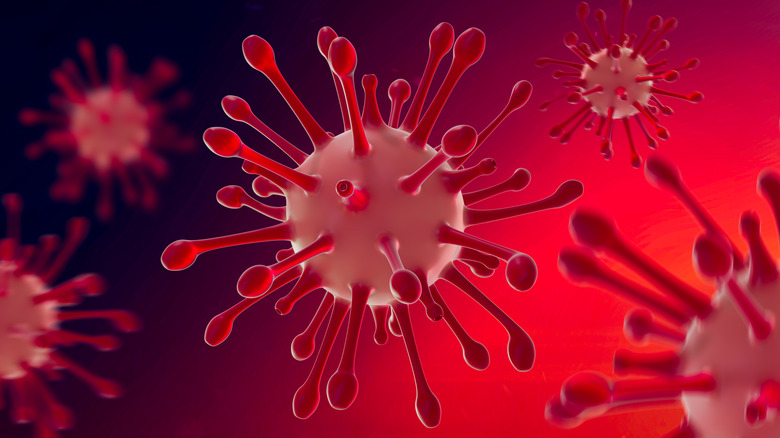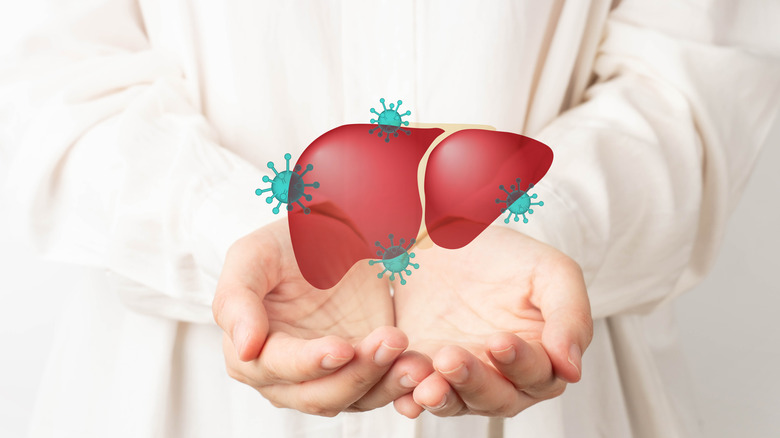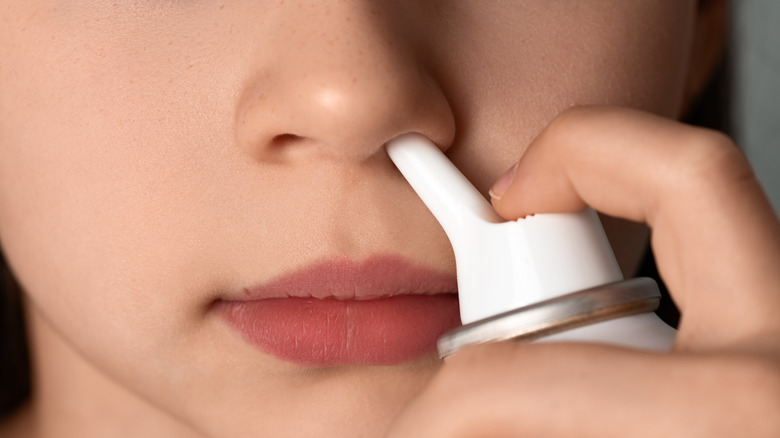Adenoviruses Explained: Everything You Need To Know
Adenoviruses are a group of viruses that are fairly common, according to the CDC. They typically cause a mild illness similar to the common cold. The CDC claims that lab tests are not usually conducted to determine whether or not a person has an adenovirus infection, in part because most infected people have mild symptoms or no symptoms at all, and there is no specific treatment that can be prescribed (as with the common cold).
However, certain types of adenovirus are associated with more serious illness, particularly among the immunocompromised. Some medications, as well as some diseases like heart disease and lung disease, can weaken the immune system, causing a person to become immunocompromised with a greater risk of serious adenovirus infection.
Currently, no adenovirus vaccines are available to the public. There is an adenovirus vaccine designed to target certain types of adenovirus, and this vaccine is given to members of the military who are determined to be at risk of infection from these specific types of adenovirus. However, this vaccine has never been scientifically studied among the general population, and is only approved for use within the military.
Here's everything you need to know about adenoviruses.
The CDC's statement on adenovirus outbreaks in children
In April of 2022, reports of severe hepatitis in previous healthy children with adenovirus infection (adenovirus type 41) began to emerge in both the US and Europe. The CDC issued a statement on April 21 to alert providers of the situation, and to explain that the root cause was still unknown. Adenovirus type 41 had previously been identified as a potential cause of hepatitis in immunocompromised children, but not in children who were otherwise healthy.
According to the CDC, a cluster of five children with severe hepatitis and adenovirus infection was discovered in Alabama in October 2021, and four more cases were identified soon after. In April 2022, at least 74 cases of hepatitis in young children were identified in the UK (via the WHO). By May of 2022, the New York Times reported that similar cases had been identified in at least 10 US states and 16 countries, and the European CDC had estimated the total number of cases to be around 200.
The CDC has said that adenovirus infection was confirmed in at least some of the European children, but not all. Apart from the virus, no common link has been identified in all such cases. Researchers were unable to identify a common exposure and are still unsure what led to all of these infections — and why they apparently caused previously healthy children to develop hepatitis.
Some adenoviruses can cause hepatitis
As we know from the April 2022 case reports of adenovirus infections in young children (via the CDC), some types of adenovirus can cause hepatitis. The 2022 outbreak appeared to be caused by adenovirus 41, a variant that had historically been linked to hepatitis in immunocompromised children.
Moreover, a 2008 case report from the Turkish Journal of Gastroenterology describes a fatal case of hepatitis in a previously healthy child that was apparently caused by adenovirus infection. So, the 2022 outbreak may not have been the first time that an adenovirus caused severe hepatitis in an otherwise healthy child, but the researchers note that this complication remains extremely rare.
According to the CDC, hepatitis refers to acute inflammation of the liver, and one of the major causes is a group of viruses. The most common are the Hepatitis A virus, the Hepatitis B virus, and the Hepatitis C virus. However, some other types of viruses can also cause hepatitis, including adenoviruses.
Adenoviruses are highly contagious
Adenoviruses are very contagious. According to the CDC, they can be spread through close contact with an infected person, or through the air where an infected person has been coughing or sneezing. Additionally, contact with the stool of an infected person (e.g. while changing diapers) can cause infection, as can swimming in a pool with water that's been contaminated by the virus, though this is less common. The CDC also notes that adenoviruses can survive on surfaces for long periods of time and are resistant to many common cleaners, so infection can happen as a result of touching a contaminated surface.
It is also possible for the virus to be spread by a previously infected person long after they've recovered. The CDC says this is especially common among the immunocompromised: They may continue to shed the virus long after they stop showing any symptoms, potentially causing infection in others even though they are no longer symptomatic.
Adenovirus infections are more common in children
According to a book from the American Journal of Respiratory and Critical Care Medicine, young children have a higher risk of developing an infection from adenoviruses. The researchers explain that this is because children lack sufficient humoral immunity, which is part of the adaptive immune system. Humoral immunity refers to the immune response that occurs in between cells, via a book about immunology. (By contrast, cell-mediated immunity refers to the immune response that happens within cells.) The humoral immune response triggers B cells to create specific antibodies in response to some harmful pathogen. The antibodies bind to the pathogen, deactivating it and preventing it from replicating itself.
An article from the Proceedings of the Royal Society B explains that the adaptive immune response takes years to mature. This makes sense, because the adaptive immune response is only as effective as the number of different pathogens it can recognize — and young children simply haven't been exposed to as many pathogens as adults. The researchers assert that this makes young children especially vulnerable to infection from viruses, bacteria, fungi, and parasites. However, they go on to claim that children typically have a good chance of surviving such infections, assuming they are adequately nourished and have access to good health care.
Adenovirus symptom: fever
Not every adenovirus infection will cause noticeable symptoms, but the most commonly reported symptoms are very similar to those of the common cold or flu.
The CDC lists fever as one of the most common symptoms of adenovirus infection. A fever is generally defined as an internal body temperature of 100 degrees Fahrenheit or higher, according to the Mayo Clinic. Fevers are a common reaction to infection and not usually cause for alarm by themselves, but when a fever reaches 103 degrees or more, it's a good idea to seek medical care.
The purpose of a fever is to kill infection-causing pathogens. These pathogens thrive at our normal body temperature, but raising the temperature just a few degrees makes it much harder for them to survive. Fevers usually go away within a few days, and you can also take over-the-counter fever reducers (such as acetaminophen) when a fever becomes too uncomfortable. When a fever lasts longer than three days, particularly in children, the Mayo Clinic recommends seeking medical care.
Adenovirus symptom: sore throat
Another common symptom of adenovirus infection is sore throat (via the CDC). According to the Virginia Department of Health, adenovirus symptoms can vary depending on the site of infection, but adenoviruses usually infect the airways. This is likely a result of becoming infected by breathing contaminated air, since the virus can travel through the air (e.g. when an infected person coughs or sneezes). When an adenovirus infection attacks the airways, this can lead to many of the symptoms we associate with respiratory infections: sore throat, runny nose, sneezing, coughing, etc.
There are a variety of ways to deal with these respiratory symptoms. The Mayo Clinic recommends drinking plenty of fluids, particularly warm beverages — but no caffeine or alcohol (which can be dehydrating). They also recommend lozenges, hard candies, soup, ice pops, honey (though honey shouldn't be given to infants), gargling with salt water, and using a cool-air humidifier as tried-and-true methods to soothe a sore throat.
Adenovirus symptom: acute bronchitis
Acute bronchitis, also known as a chest cold (via the CDC), can happen as a result of adenovirus infection. Acute bronchitis happens when the airways become inflamed, creating mucus in the lungs. This causes you to cough, and the cough will usually be productive (meaning it contains mucus). However, it may also be dry. Acute bronchitis may also be referred to as a cough.
A study from the Canadian Family Physician claims viruses cause between 85% to 95% of all cases of acute bronchitis in adults, and the researchers list adenovirus as one of the most common viruses causing acute bronchitis. Bacteria can also cause acute bronchitis, but this is more rare. That said, the CDC claims antibiotics should never be prescribed for acute bronchitis, even if the infection was caused by bacteria. They state several times that antibiotics will not help you get better if you have acute bronchitis.
Acute bronchitis will usually get better on its own, but it can be alleviated by drinking plenty of fluids, sucking on lozenges, eating honey (or adding it to a warm beverage), using a humidifier, breathing in steam from hot water, etc. — many of the same strategies we use to help treat sore throats.
Adenovirus symptom: pneumonia
Severe adenovirus infection can lead to pneumonia (via the CDC). Pneumonia is an infection of the lungs, and it can affect one or both of the lungs. As Johns Hopkins Medicine explains, this is a serious condition in which the infected lung or lungs become filled with pus or other fluids, which can cause difficulty breathing, among a variety of other complications. About one third of all cases of pneumonia are caused by viral infections.
The most common signs of pneumonia include a productive cough (which may include bloody mucus), sharp chest pain that's exacerbated by deep breathing and coughing, shortness of breath, extreme fatigue, rapid pulse, and loss of appetite. Pneumonia can be diagnosed in a variety of ways, including via chest X-ray or CT scan, blood tests, or sputum culture (referring to a test that's done on the mucus that gets coughed up).
Treatment will depend on the type of pneumonia a person has. For instance, antibiotics are often prescribed to treat bacterial pneumonia, but these won't help (and may cause additional harm) for pneumonia caused by a virus. Johns Hopkins Medicine claims that most cases of viral pneumonia can be treated at home and will get better on their own, but hospitalization may be necessary in severe cases.
Adenovirus symptom: acute gastroenteritis
Some adenoviruses can cause acute gastroenteritis (via the CDC). This refers to inflammation of the stomach or digestive tract, and it can cause stomach pain, nausea, diarrhea, and/or vomiting — all of which are also considered symptoms of adenovirus infection.
Adenoviruses that infect the digestive tract are referred to as enteric adenoviruses. However, non-enteric adenoviruses can also cause acute gastroenteritis, according to a study from PLOS One. The study looked at cases of acute gastroenteritis in young children in Thailand from 2011 to 2017, and adenovirus infection was found in about 7.2% of these cases. Additionally, the researchers found both enteric and non-enteric types of adenovirus could be responsible for causing acute gastroenteritis. Per the study's findings, adenovirus infection causes between 2% and 10% of all cases of diarrhea in children worldwide. Diarrhea and acute gastroenteritis are major causes of mortality among infants and young children across the globe, and the researchers claim adenovirus "has been recognized as one of the most important pathogens responsible for diarrhea."
While there is no specific treatment for acute gastroenteritis caused by a virus, it will usually go away on its own, and self-care (e.g. drinking plenty of fluids and getting plenty of rest) can help it heal faster.
Adenovirus symptom: pink eye (conjunctivitis)
Pink eye, also known as conjunctivitis, can also be caused by some types of adenovirus (via a book from the American Journal of Respiratory and Critical Care Medicine). According to the Mayo Clinic, a majority of pink eye cases can be attributed to adenovirus infection. Other viruses can also cause pink eye, as can bacteria, allergies, and certain types of injury to the eyes (e.g., contact with a foreign object or chemical).
Pink eye refers to inflammation of the transparent membrane, or conjunctiva, that lines both the eyelids and the surface of the white part of the eyeballs. Pink eye gets its name from the appearance of an infected eye, in which small blood vessels are inflamed and thus more visible, making the eye appear pink or red in color. The most common symptoms are redness or itchiness in one or both eyes, and tears or other fluid discharges from one or both eyes that can dry overnight and make it difficult to open your eyes in the morning.
Adenovirus treatment: over-the-counter fever reducers
As with most viruses, there is no specific treatment for adenovirus infections. Antibiotics won't help, as these only treat bacterial infections (and can cause harm when taken unnecessarily). With most viral infections, getting better is a matter of being patient and allowing your body to fight off the virus. However, there are a variety of things you can do to help your body heal more quickly from adenovirus infection, most of which involve treating your specific symptoms.
For instance, the CDC recommends over-the-counter fever reducers and pain relievers to help manage the infection. If you have a fever, it's a good idea to take something to help your body temperature go down. Even if you don't have a fever, these medications can help treat headaches and body aches, both of which are also symptoms of viral infection. Just be sure not to exceed the maximum daily dose listed on the bottle.
Adenovirus treatment: get plenty of rest and drink plenty of fluids
When treating a viral infection (or any kind of infection), getting sufficient rest is absolutely essential to recovery (via KidsHealth). This is because deep sleep triggers the production of important infection-fighting cells in the immune system (via WebMD). In other words, sleep helps to strengthen your immune system, which is especially important when you're fighting an infection. It gives your body a chance to catch up in its fight against the virus causing the infection.
According to KidsHealth, drinking plenty of fluids is also essential to help you recover from adenovirus infection. This is especially important when symptoms of the infection include diarrhea and vomiting, since both cause the depletion of essential body fluids. In such cases, instead of just drinking water, it may be a good idea to add an oral rehydration solution — or failing that, a pinch of salt — to the water in order to make sure you're replenishing essential electrolytes as well as water.
Adenovirus treatment: use a humidifier or saltwater nose drops
For adenoviruses that cause acute respiratory infections — for instance, when symptoms include sore throat, runny nose, congestion, cough, bronchitis, etc. -– you can try a humidifier or saltwater nose drops (via KidsHealth). These methods won't necessarily help you fight the virus, but they'll alleviate many of the respiratory symptoms associated with the virus that may be causing pain or discomfort.
Saltwater nose drops can be purchased over the counter as saline nasal sprays, but you can also make your own saline solution at home. However, as Healthline points out, it's essential that you use sterilized water when making this solution yourself. This is because a certain type of parasitic amoeba can cause a fatal infection when it enters the body through the nostrils. You can sterilize your water by boiling it for a minute, then allowing it to cool before using it for your saline solution. When your water is ready, you can add pure salt to create the saline solution, but it's even more effective to use over-the-counter saline packets.
You can also purchase a humidifier to help alleviate respiratory symptoms, but another option is to simply inhale steam from hot water (per Healthline). If you regularly boil water for tea or coffee (or any other purpose), inhaling the steam while the water is boiling can help to relieve congestion.
Adenovirus prevention: stay home when you feel sick and avoid close contact with others
The adenovirus vaccine is only available for military personnel, and not for the general public (via the CDC). However, there are other ways to prevent adenovirus infection apart from vaccines. Wash your hands regularly with soap and water, and avoid touching your eyes, nose, or mouth unless you've just washed your hands. You should also avoid close contact with an infected person.
Given that close contact with infected people is one of the primary ways the virus spreads, the CDC also recommends staying home when you're sick, and making sure to avoid close contact with others. Note that this applies not just to the adenovirus, but to any sort of infection that has the potential to be contagious. When you're feeling sick, the safest thing for both you and others is to stay home. Use tissues or your upper shirt sleeve (and not your hands) when coughing or sneezing, and avoiding sharing cups or utensils. Lastly, maintaining adequate levels of chlorine in swimming pools can also help to limit the spread of the virus in pools.















